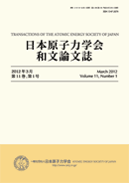
- Issue 4 Pages 99-
- Issue 3 Pages 52-
- Issue 2 Pages 38-
- Issue 1 Pages 1-
- |<
- <
- 1
- >
- >|
-
Yoshitaka Ohkubo, Minoru Tanigaki, Shuichi Tsuda2025Volume 24Issue 4 Pages 99-104
Published: 2025
Released on J-STAGE: November 15, 2025
Advance online publication: October 15, 2025JOURNAL FREE ACCESS FULL-TEXT HTMLWe present a Fortran 90/95 code for computing the G(E) function, which transforms a gamma-ray pulse height spectrum to the ambient dose equivalent [H*(10)] rate, to make the G(E) function more easily accessible to any interested party. Our program code uses as input data pulse height spectra at various energies for a specific gamma-ray detector and the values of H*(10) per unit fluence at the corresponding energies, both of which are obtained with the PHITS code.
View full abstractDownload PDF (1441K) Full view HTML
-
Heat Fluxes for Natural Convection Condensation on a Vertical Flat Plate from Steam and Air MixturesToshiya TAKAKI, Michio MURASE, Koji MIYOSHI2025Volume 24Issue 4 Pages 105-116
Published: 2025
Released on J-STAGE: November 15, 2025
Advance online publication: October 10, 2025JOURNAL FREE ACCESS FULL-TEXT HTMLIn this study, numerical computations of condensation heat fluxes along a vertical flat plate from steam and air mixtures in a rectangular flow channel with a condensation height of 6 m were carried out using the computational fluid dynamics (CFD) code FLUENT to evaluate condensation heat fluxes qc on the containment wall under accident conditions. The distributions of the computed heat flux qx,CFD values along the flow direction x agreed relatively well with those of the qx,exp values measured with the COPAIN facility with a condensation height of 2 m at a steam mass fraction of Ys,in = 0.133–0.233, and the standard deviation of the qx,CFD values to the qx,exp values was s = 13%. The qx,CFD values were numerically obtained with a mixture velocity range of uin = 0.27–3.2 m/s at Ys,in = 0.453, and they were compared with the qc,NC values computed by existing correlations for natural convection (NC) condensation. A combination of a qc correlation and a correlation for the Sherwood number Shx,NC in the qc correlation was evaluated, the coefficient for Shx,NC was optimized, and the standard deviation of the qx,NC values to the qx,exp or qx,CFD values was s = 16%.
View full abstractDownload PDF (1548K) Full view HTML -
Takuya TORIYAMA, Masashi HIRANO, Nobuo ISHIDA2025Volume 24Issue 4 Pages 117-129
Published: 2025
Released on J-STAGE: November 15, 2025
Advance online publication: November 08, 2025JOURNAL FREE ACCESS FULL-TEXT HTMLConsidering the submersion of equipment installed in a building with a watertight door, the failure probability of the equipment owing to tsunami inundation is affected by leakage through the watertight door. The leakage has the characteristic of surging at an uncertain threshold. This study is aimed at developing the methodology of fragility evaluation that takes into account the uncertainties of the threshold. The evaluation methods with three grades based on the level of detail in assessment were proposed. The parameters in fragility evaluation were evaluated from the results of previous leakage tests of watertight doors. Each method was validated by comparing the fragility curves based on the proposed method with those obtained by the Monte-Carlo method. As a result of a comparison between the fragility curves for three grades, two characteristics were revealed. The first was that the failure probabilities are higher for the lower grades than for the higher grades. The second was that the failure probability for the lowest grade surges at a specific point since the threshold is conservatively calculated. The level of detail required in the assessment should be considered to select the appropriate method.
View full abstractDownload PDF (2248K) Full view HTML
- |<
- <
- 1
- >
- >|